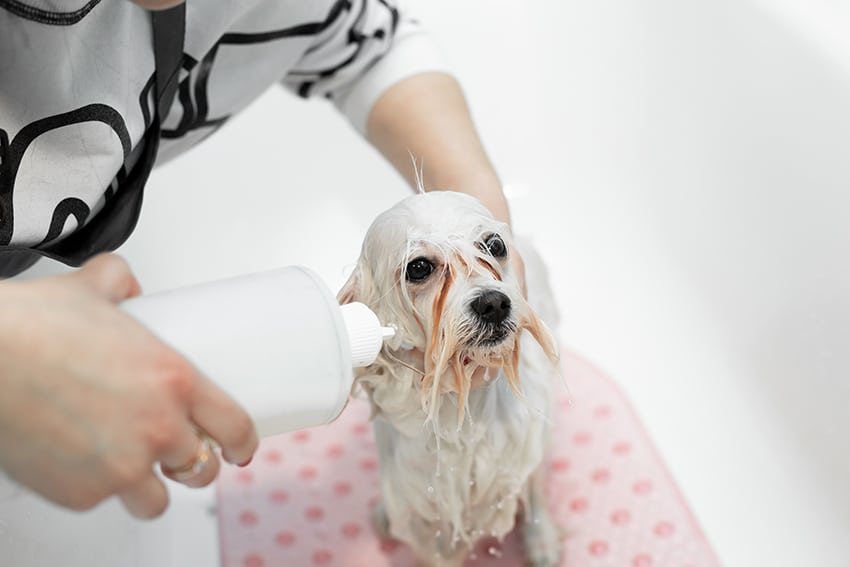We’ve all had an itch at some point in our lives, now imagine that as a constant in your life; one from which you cannot get any relief. That’s what our pooches with allergies are going through, intense pruritic lesions that severely impact their quality of life, even waking them up from their sleep and interrupting a leisurely walk on a Sunday.
I see “itchy” in my appointment schedule multiple times a day and it breaks my heart. While medication is often needed to provide rapid relief for my patients, I often prescribe adjunctive treatments such as dietary modification and soothing shampoos. While typical oatmeal and aloe-vera-containing products are helpful, some dogs with severe allergies need an even more specially formulated treatment. That’s where hypoallergenic shampoos play a role.
What is Hypoallergenic dog shampoo?
The best definition for hypoallergenic is a product that is unlikely to cause an allergic response, but there’s no legal or protected definition and so there’s a huge range of hypoallergenic shampoos on the market.
It’s important to remember that just because a product is considered hypoallergenic doesn’t mean it won’t cause an allergic reaction in some dogs. In fact, the sale and marketing of these products aren’t regulated by the FDA.
Not all of these are suitable for your dog, but some research will help you make the best purchase for your fur-baby.
Hypoallergenic products should contain ingredients that are unlikely to elicit an allergic response in dogs. This does not mean that it won’t cause an allergic reaction in all animals.
Does Hypoallergenic dog shampoo work?
For the most part, hypoallergenic shampoos do provide relief for itchy and inflamed skin. Topical treatments such as these shampoos act locally and directly on your dog’s skin helping to cleanse and remove flaky skin while providing hydration to the skin and soothing inflammation.
The first thing we should look for when using hypoallergenic or therapeutic topical treatments is a reduction in your dog’s scratching and reduced redness in the affected areas.
Did you know that in the 60s veterinarian’s actually recommended not bathing dog’s with itchy skin? Research has thankfully shown that bathing is actually beneficial for these patients (once it’s not overdone).
In the past few decades, shampoos have been increasing in their acceptance and use in the USA which has led to more research and newer, more efficacious products becoming available.
In general, hypoallergenic shampoos do work for dogs suffering from allergic skin conditions or itchy greasy skin. In the past 25 years or so their use has increased and as a result, we have more effective products on the market, thus improving our dog’s treatment options and relief.
Who should use Hypoallergenic dog shampoo?
Prescription shampoos may be advised by your veterinarian for specific skin conditions while more widely available hypoallergenic products available from dog stores can be used to provide relief for dogs with mild pruritus.
Not all of these products are suitable for every dog so always consider your dog’s specific needs and if using a new product always test with a small amount first and wait at least 24 hours before bathing your dog fully.
If your dog suffers with skin allergies or takes regular walks in areas of long grass and high pollen areas then bathing with hypoallergenic shampoos may help. The moisturizing action coupled with the physical cleansing of pollen and environmental allergens from your pooch’s fur will help maintain their itch-free status.
How does Hypoallergenic dog shampoo work?
Generally, shampoos are water-based solutions that include surfactants, cleansing agents, and some other ingredients designed for specific conditions. The goal is to clear debris from the skin’s surface and hair follicles through mechanical means.
The aqueous base hydrates the outermost layer of the skin, persistent hydration requires added moisturizers within the product. These shampoos aren’t the same as medicated ones (though some may contain medications and therapeutic ingredients) and don’t treat underlying issues.
Shampoos tend to require multiple frequent applications and often a double application on their first use. The goal of this is to first allow the mechanical removal of skin scales and debris which are then rinsed away, this application will also remove most environmental allergens and dirt from your dog’s coat simultaneously. A second application is generally allowed to “sit” on the skin for up to 15 minutes (often tricky with a wriggly, wet pooch) to allow absorption into the deeper skin layers to work before being thoroughly rinsed away.
Hypoallergenic shampoos work through a combination of rehydration of your dog’s outer skin layer and the mechanical removal of skin debris. The effects of these shampoos are temporary unless they have incorporated moisturizers.
How often should I use Hypoallergenic shampoo on my dog?
Therapeutic shampoos generally require multiple weekly applications for one or two weeks while commercially available hypoallergenic shampoos not targeting specific conditions are generally applied every one to two weeks.
The frequency of application of hypoallergenic shampoos varies widely depending on whether they have a target condition to treat or are being used as a general cleansing and soothing product.
Is Hypoallergenic shampoo safe for puppies?
As a general rule, puppies don’t really need bathing before 8-12 weeks of age unless they get very dirty as in the case of diarrhea. Caution should be used when bathing puppies as they struggle to regulate their body temperature and can easily become hypothermic.
Hypoallergenic shampoos can be a good option for bathing their delicate skin once you avoid their delicate eyes, ears, and mouth area. You should also avoid using medicated shampoos unless directed by your veterinarian.
Hypoallergenic shampoo active ingredients overview
When selecting a hypoallergenic shampoo for your pooch you should look for products that disclose all of their ingredients (this isn’t actually a legal requirement in many countries). Don’t rely on the schtick of “all-natural ingredients” or “no harsh chemicals” as these are generic terms that don’t actually mean anything specific.
You should look for a product with a minimal number of ingredients and avoid unnecessary ones such as perfumes and dyes that can cause skin inflammation in sensitive pooches with already irritated skin. Also, remember not all herbal or essential oil-containing products are suitable for sensitive skin and some may exacerbate irritation in some pooches.
Just because a product uses Latin herb names or chemical terms doesn’t mean these are bad. Many of these are completely safe and may be present as an antimicrobial preservative without necessarily meaning something nasty is inside. If you want to avoid preservatives as much as possible, select products that come in smaller packages and have short expiration dates.
Some of the most common ingredients that are generally considered included in hypoallergenic products include:
- Aloe Vera: Known to have cooling and anti-inflammatory benefits for humans, aloe vera helps provide moisture to your dog’s skin alongside being full of antioxidants.
- Oatmeal: While oatmeal is moisturizing, it can also provide gentle exfoliative cleansing to your pooch’s skin while reducing inflammation.
- Coconut: Considered to support wound healing, coconut oil moisturizes and reduces inflammation while it may also provide antimicrobial benefits.
- Fat soluble vitamins such as vitamins E and A: These vitamins are often listed in hypoallergenic shampoos but their benefits are mostly gleaned from their presence in your dog’s diet.
- Shea butter: Another moisturizing natural product, shea butter helps to soothe skin through this while it may also promote healing of broken skin and contains antioxidants.
- Allantoin: Another exfoliating product, this soothing product provides hydration while supporting skin cell regeneration.
- Panthenol: The main function of panthenol is as a humectant that attracts and holds moisture within the skin to help provide protection while allowing your fur-baby’s skin to produce its own internal hydration.
Are waterless shampoos suitable?
A relatively recent addition to the dog grooming market, waterless and no-rinse shampoos are often marketed as moisturizing, easy solutions to dog cleanliness between baths.
These shampoos may not be suitable for your dog if they have sensitive or inflamed skin as their active ingredients aren’t rinsed away and may exacerbate issues when left on your dog’s skin.
Overview of popular hypoallergenic shampoos for dogs
There are huge numbers of dog shampoos advertised as “all-natural” and “hypoallergenic” on the market. So much so that it can be difficult to select the best and safest for your precious fur-baby.
We’ve selected some of the most popular brands available to help you make an informed decision.
As a vet, I personally like all of these products (otherwise I wouldn’t endorse them) so it’s a close call for our favorite. So, I’ve selected my top two instead:
Burt’s Bees for Dogs Hypoallergenic Dog Shampoo
This cruelty-free shampoo is formulated without sulfates, colors, essential oils, or fragrances. Burt’s Bees are a well-known and trusted company in human skincare and this pH-balanced shampoo is affordable and contains natural ingredients known for their healthy skin-promoting properties.
Veterinary Formula Clinical Care Hypoallergenic Shampoo for Dogs
Another trusted company, this hypoallergenic shampoo won’t wash away flea and tick medications when used as directed. Sulfate and paraben-free, this shampoo is also fragrance-free and is touted as a tear-free formula for dog’s (you should still avoid their delicate face area). Specifically formulated to treat dry and sensitive skin, the inclusion of lactic acid and allantoin acts to moisturize your pupper’s tender skin.
The Final Woof
We hope that now you’ve read through our informative hypoallergenic dog shampoo article, you feel better equipped to select the best product for your dog’s special requirements.
If you’ve read some of our other articles you know that I always advocate speaking with your primary care DVM when you’re concerned about what to use on your dog’s skin. This is especially important if your dog has severely pruritic skin that they’ve already traumatized with chewing or scratching.
The take-home point to remember is that not all hypoallergenic shampoos will be suitable for your dog.
These products are formulated to be as low risk as possible for causing adverse skin reactions, but always test a new product on a small area of your dog’s skin to ensure your dog won’t have a reaction before general use.


